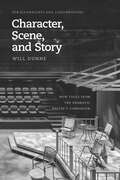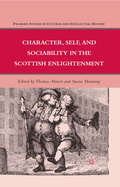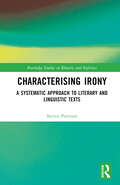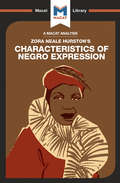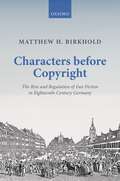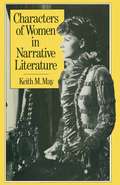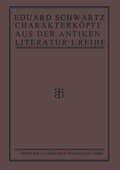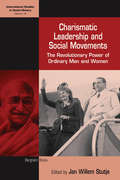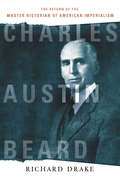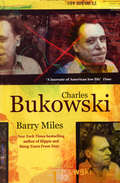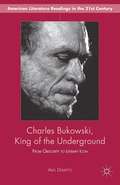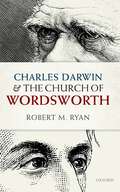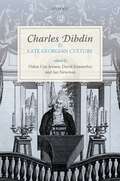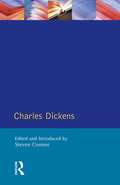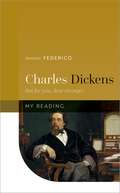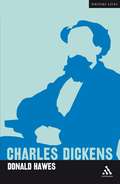- Table View
- List View
Character, Scene, and Story: New Tools from the Dramatic Writer's Companion (Chicago Guides to Writing, Editing, and Publishing)
by Will DunneWill Dunne first brought the workshop experience down to the desk level with The Dramatic Writer’s Companion, offering practical exercises to help playwrights and screenwriters work through the problems that arise in developing their scripts. Now writers looking to further enhance their storytelling process can turn to Character, Scene, and Story. Featuring forty-two new workshop-tested exercises, this sequel to The Dramatic Writer’s Companion allows writers to dig deeper into their scripts by fleshing out images, exploring characters from an emotional perspective, tapping the power of color and sense memory to trigger ideas, and trying other visceral techniques. The guide also includes a troubleshooting section to help tackle problem scenes. Writers with scripts already in progress will find they can think deeper about their characters and stories. And those who are just beginning to write will find the guidance they need to discover their best starting point. The guide is filled with hundreds of examples, many of which have been developed as both plays and films. Character, Scene, and Story is fully aligned with the new edition of The Dramatic Writer’s Companion, with cross-references between related exercises so that writers have the option to explore a given topic in more depth. While both guides can stand alone, together they give writers more than one hundred tools to develop more vivid characters and craft stronger scripts.
Character, Scene, and Story: New Tools from the Dramatic Writer's Companion (Chicago Guides to Writing, Editing, and Publishing)
by Will DunneWill Dunne first brought the workshop experience down to the desk level with The Dramatic Writer’s Companion, offering practical exercises to help playwrights and screenwriters work through the problems that arise in developing their scripts. Now writers looking to further enhance their storytelling process can turn to Character, Scene, and Story. Featuring forty-two new workshop-tested exercises, this sequel to The Dramatic Writer’s Companion allows writers to dig deeper into their scripts by fleshing out images, exploring characters from an emotional perspective, tapping the power of color and sense memory to trigger ideas, and trying other visceral techniques. The guide also includes a troubleshooting section to help tackle problem scenes. Writers with scripts already in progress will find they can think deeper about their characters and stories. And those who are just beginning to write will find the guidance they need to discover their best starting point. The guide is filled with hundreds of examples, many of which have been developed as both plays and films. Character, Scene, and Story is fully aligned with the new edition of The Dramatic Writer’s Companion, with cross-references between related exercises so that writers have the option to explore a given topic in more depth. While both guides can stand alone, together they give writers more than one hundred tools to develop more vivid characters and craft stronger scripts.
Character, Scene, and Story: New Tools from the Dramatic Writer's Companion (Chicago Guides to Writing, Editing, and Publishing)
by Will DunneWill Dunne first brought the workshop experience down to the desk level with The Dramatic Writer’s Companion, offering practical exercises to help playwrights and screenwriters work through the problems that arise in developing their scripts. Now writers looking to further enhance their storytelling process can turn to Character, Scene, and Story. Featuring forty-two new workshop-tested exercises, this sequel to The Dramatic Writer’s Companion allows writers to dig deeper into their scripts by fleshing out images, exploring characters from an emotional perspective, tapping the power of color and sense memory to trigger ideas, and trying other visceral techniques. The guide also includes a troubleshooting section to help tackle problem scenes. Writers with scripts already in progress will find they can think deeper about their characters and stories. And those who are just beginning to write will find the guidance they need to discover their best starting point. The guide is filled with hundreds of examples, many of which have been developed as both plays and films. Character, Scene, and Story is fully aligned with the new edition of The Dramatic Writer’s Companion, with cross-references between related exercises so that writers have the option to explore a given topic in more depth. While both guides can stand alone, together they give writers more than one hundred tools to develop more vivid characters and craft stronger scripts.
Character, Scene, and Story: New Tools from the Dramatic Writer's Companion (Chicago Guides to Writing, Editing, and Publishing)
by Will DunneWill Dunne first brought the workshop experience down to the desk level with The Dramatic Writer’s Companion, offering practical exercises to help playwrights and screenwriters work through the problems that arise in developing their scripts. Now writers looking to further enhance their storytelling process can turn to Character, Scene, and Story. Featuring forty-two new workshop-tested exercises, this sequel to The Dramatic Writer’s Companion allows writers to dig deeper into their scripts by fleshing out images, exploring characters from an emotional perspective, tapping the power of color and sense memory to trigger ideas, and trying other visceral techniques. The guide also includes a troubleshooting section to help tackle problem scenes. Writers with scripts already in progress will find they can think deeper about their characters and stories. And those who are just beginning to write will find the guidance they need to discover their best starting point. The guide is filled with hundreds of examples, many of which have been developed as both plays and films. Character, Scene, and Story is fully aligned with the new edition of The Dramatic Writer’s Companion, with cross-references between related exercises so that writers have the option to explore a given topic in more depth. While both guides can stand alone, together they give writers more than one hundred tools to develop more vivid characters and craft stronger scripts.
Character, Self, and Sociability in the Scottish Enlightenment (Palgrave Studies in Cultural and Intellectual History)
by Thomas Ahnert and Susan ManningAn interdisciplinary examination of the Enlightenment character and its broader significance. Whilst the main focus of the book is the Scottish Enlightenment, contributors also employ a transatlantic scope by considering parallel developments in Europe, and America.
Characterising Irony: A Systematic Approach to Literary and Linguistic Texts (Routledge Studies in Rhetoric and Stylistics)
by Steven PattisonThis book offers a systematic, bottom-up account of irony across both everyday contexts and literary and linguistic texts, using an empirically rigorous approach in distinguishing between central irony, non-central ironies, and non-ironies and highlighting a new way forward for irony research. The volume considers the current landscape of irony, in which the term is used with increasing frequency with the knock-on effect of a loosening of its meaning. Pattison addresses this challenge by applying a systematic form of analysis, rooted in frameworks from pragmatics and complementary disciplines, to a database of over 500 irony candidates from a wide range of sources. The book uses these examples to illustrate the features of central ironies as well as the attributes used to differentiate between central ironies, non-central ironies, and non-ironies. These attributes are mapped across four key domains, including: difference and opposition; the role of context; how ironies are signaled; and speaker attitude and intention. Taken together, the volume puts forth a credible account for more clearly characterizing examples of irony and equips researchers with a comprehensive step-by-step method for undertaking future research. This book is key reading for scholars in stylistics, pragmatics, literary studies, and psycholinguistics.
Characterising Irony: A Systematic Approach to Literary and Linguistic Texts (Routledge Studies in Rhetoric and Stylistics)
by Steven PattisonThis book offers a systematic, bottom-up account of irony across both everyday contexts and literary and linguistic texts, using an empirically rigorous approach in distinguishing between central irony, non-central ironies, and non-ironies and highlighting a new way forward for irony research. The volume considers the current landscape of irony, in which the term is used with increasing frequency with the knock-on effect of a loosening of its meaning. Pattison addresses this challenge by applying a systematic form of analysis, rooted in frameworks from pragmatics and complementary disciplines, to a database of over 500 irony candidates from a wide range of sources. The book uses these examples to illustrate the features of central ironies as well as the attributes used to differentiate between central ironies, non-central ironies, and non-ironies. These attributes are mapped across four key domains, including: difference and opposition; the role of context; how ironies are signaled; and speaker attitude and intention. Taken together, the volume puts forth a credible account for more clearly characterizing examples of irony and equips researchers with a comprehensive step-by-step method for undertaking future research. This book is key reading for scholars in stylistics, pragmatics, literary studies, and psycholinguistics.
Characteristics of Negro Expression (The Macat Library)
by Mercedes Aguirre Benjamin LempertThe racial prejudices of 1930s America were many, and included a common presumption that African American art was unoriginal – merely poorly copying white culture. African-American novelist, anthropologist and essayist Zora Neale Hurston crushingly evaluated such assumptions in her 1934 essay ‘Characteristics of Negro Expression.’ While Hurston’s approach and premises seem in many ways dated to modern readers, the essay still shows an incisive mind carefully evaluating arguments and cutting them down to size. African-American art of the time did not – Hurston influentially argued – play by the same rules as white art, so it could not meaningfully be discussed by ‘white’ notions of aesthetic value. Where white European tradition views art as something fixed, Hurston saw African-American art works as a distinctive form of mimicry, reshaping and altering the original object until it became something new and novel. In this way, she contended, African-American creative expression is a process that generates its own form of originality – turning borrowed material into something original and unique. By carefully evaluating the relevance of previous arguments, Hurston showed African American artistic expression in an entirely new light.
Characteristics of Negro Expression (The Macat Library)
by Mercedes Aguirre Benjamin LempertA critical analysis of African-American novelist and anthropologist Zora Neale Hurston' 1934 essay Characteristics of Negro Expression: A crushing evaluation of the many racial prejudices of 1930s America, including a common presumption that African American art was unoriginal – merely poorly copying white culture. Hurston’s approach and premises may seem in many ways dated to modern readers, but the essay still shows an incisive mind carefully evaluating arguments and cutting them down to size. African-American art of the time did not – Hurston influentially argued – play by the same rules as white art, so it could not meaningfully be discussed by ‘white’ notions of aesthetic value. Where white European tradition views art as something fixed, Hurston saw African-American art works as a distinctive form of mimicry, reshaping and altering the original object until it became something new and novel. In this way, she contended, African-American creative expression is a process that generates its own form of originality – turning borrowed material into something original and unique. By carefully evaluating the relevance of previous arguments, Hurston showed African American artistic expression in an entirely new light.
Characters Before Copyright: The Rise and Regulation of Fan Fiction in Eighteenth-Century Germany (Law and Literature)
by Matthew H. BirkholdHow did authors control the literary fates of fictional characters before the existence of copyright? Could a second author do anything with another author's character? Situated between the decline of the privilege system and the rise of copyright, literary borrowing in eighteenth-century Germany has long been considered unregulated. This book tells a different story. Characters before Copyright documents the surprisingly widespread eighteenth-century practice of writing fan fictionliterary works written by readers who appropriate preexisting characters invented by other authorsand reconstructs the contemporaneous debate about the literary phenomenon. Like fan fiction today, these texts took the form of sequels, prequels, and spinoffs. Analyzing the evolving reading, writing, and consumer habits of late-eighteenth-century Germany, Characters before Copyright identifies the social, economic, and aesthetic changes that fostered the rapid rise of fan fiction after 1750. Based on archival work and an ethnographic approach borrowed from legal anthropology, this book then uncovers the unwritten customary norms that governed the production of these works. Characters before Copyright thus reinterprets the eighteenth-century literary commons, arguing that what may appear to have been the free circulation of characters was actually circumscribed by an exacting set of rules and conditions. These norms translated into a unique type of literature that gave rise to remarkable forms of collaborative authorship and originality. Characters before Copyright provides a new perspective on the eighteenth-century book trade and the rise of intellectual property, reevaluating the concept of literary property, the history of moral rights, and the tradition of free culture.
Characters Before Copyright: The Rise and Regulation of Fan Fiction in Eighteenth-Century Germany (Law and Literature)
by Matthew H. BirkholdHow did authors control the literary fates of fictional characters before the existence of copyright? Could a second author do anything with another author's character? Situated between the decline of the privilege system and the rise of copyright, literary borrowing in eighteenth-century Germany has long been considered unregulated. This book tells a different story. Characters before Copyright documents the surprisingly widespread eighteenth-century practice of writing fan fictionliterary works written by readers who appropriate preexisting characters invented by other authorsand reconstructs the contemporaneous debate about the literary phenomenon. Like fan fiction today, these texts took the form of sequels, prequels, and spinoffs. Analyzing the evolving reading, writing, and consumer habits of late-eighteenth-century Germany, Characters before Copyright identifies the social, economic, and aesthetic changes that fostered the rapid rise of fan fiction after 1750. Based on archival work and an ethnographic approach borrowed from legal anthropology, this book then uncovers the unwritten customary norms that governed the production of these works. Characters before Copyright thus reinterprets the eighteenth-century literary commons, arguing that what may appear to have been the free circulation of characters was actually circumscribed by an exacting set of rules and conditions. These norms translated into a unique type of literature that gave rise to remarkable forms of collaborative authorship and originality. Characters before Copyright provides a new perspective on the eighteenth-century book trade and the rise of intellectual property, reevaluating the concept of literary property, the history of moral rights, and the tradition of free culture.
Charakterköpfe aus der Antiken Literatur: Erste Reihe
by Eduard SchwartzDieser Buchtitel ist Teil des Digitalisierungsprojekts Springer Book Archives mit Publikationen, die seit den Anfängen des Verlags von 1842 erschienen sind. Der Verlag stellt mit diesem Archiv Quellen für die historische wie auch die disziplingeschichtliche Forschung zur Verfügung, die jeweils im historischen Kontext betrachtet werden müssen. Dieser Titel erschien in der Zeit vor 1945 und wird daher in seiner zeittypischen politisch-ideologischen Ausrichtung vom Verlag nicht beworben.
Charismatic Leadership and Social Movements: The Revolutionary Power of Ordinary Men and Women (International Studies in Social History #19)
by Jan Willem StutjeMuch of the writing on charisma focuses on specific traits associated with exceptional leaders, a practice that has broadened the concept of charisma to such an extent that it loses its distinctiveness – and therefore its utility. More particularly, the concept’s relevance to the study of social movements has not moved beyond generalizations. The contributors to this volume renew the debate on charismatic leadership from a historical perspective and seek to illuminate the concept’s relevance to the study of social movements. The case studies here include such leaders as Mahatma Gandhi; the architect of apartheid, Daniel F. Malan; the heroine of the Spanish Civil War, Dolores Ibarruri (la pasionaria); and Mao Zedong. These charismatic leaders were not just professional politicians or administrators, but sustained a strong symbiotic relationship with their followers, one that stimulated devotion to the leader and created a real group identity.
Charles Austin Beard: The Return of the Master Historian of American Imperialism
by Richard DrakeRichard Drake presents a new interpretation of Charles Austin Beard's life and work. The foremost American historian and a leading public intellectual in the first half of the twentieth century, Beard participated actively in the debates about American politics and foreign policy surrounding the two world wars. Drake takes this famous man's life and rewrites his intellectual biography by placing the European dimension of Beard's thought at the center. This radical change of critical focus allows Drake to correct previous biographers' oversights and, in Charles Austin Beard, present a far more nuanced appreciation for Beard's life than we have read before.Drake proposes a restoration of Beard's professional reputation, which he lost in large part because of his extremely unpopular opposition to America's intervention in World War II. Drake analyzes the stages of Beard's development as a historian and critic: his role as an intellectual leader in the Progressive movement, the support that he gave to the cause of American intervention in World War I, and his subsequent revisionist repudiation of Wilsonian ideals and embrace of non-interventionism in the lead-up to World War II. Many of his dire predictions about the inevitable consequences of pre-World War II American foreign policy have come to pass. Drake shows that, as Americans tally the ruinous costs—both financial and moral—of nation-building and informal empire, the life and work of this prophet of history merit a thorough reexamination.
Charles Bukowski
by Barry Miles'Fear makes me a writer, fear and a lack of confidence'Charles Bukowski chronicled the seedy underside of the city in which he spent most of his life, Los Angeles. His heroes were the panhandlers and hustlers, the drunks and the hookers, his beat the racetracks and strip joints and his inspiration a series of dead-end jobs in warehouses, offices and factories. It was in the evenings that he would put on a classical record, open a beer and begin to type...Brought up by a violent father, Bukowski suffered childhood beatings before developing horrific acne and withdrawing into a moody adolescence. Much of his young life epitomised the style of the Beat generation - riding Greyhound buses, bumming around and drinking himself into a stupor. During his lifetime he published more than forty-five books of poetry and prose, including the novels Post Office, Factotum, Women and Pulp. His novels sold millions of copies worldwide in dozens of languages.In this definitive biography Barry Miles, celebrated author of Jack Kerouac: King of the Beats, turns his attention to the exploits of this hard-drinking, belligerent wild man of literature.
Charles Bukowski, King of the Underground: From Obscurity to Literary Icon (American Literature Readings in the 21st Century)
by A. DebrittoThis critical study of the literary magazines, underground newspapers, and small press publications that had an impact on Charles Bukowski's early career, draws on archives, privately held unpublished Bukowski work, and interviews to shed new light on the ways in which Bukowski became an icon in the alternative literary scene in the 1960s.
Charles Darwin and the Church of Wordsworth (Oxford English Monographs)
by Robert M. RyanCharles Darwin and the Church of William Wordsworth is a study of the cultural connections between two of the nineteenth century's most influential figures, Charles Darwin and William Wordsworth. When Darwin presented On the Origin of Species, his reading public's affective response to the natural world had already been profoundly influenced by William Wordsworth. Wordsworth presented nature as benign, harmonious, a source of moral inspiration and spiritual blessing, and a medium through which one might enter into communion with the Divine. Long after his death, he continued to be revered throughout the English-speaking world, not only as a great poet, but as a theologian with a broader following than any prelate and an appeal that transcended or ignored sectarian differences. For believers and sceptics alike, Wordsworth's poetry offered a readily accessible and intellectually respectable counterweight to Darwin's vision of a material universe evolving by fixed laws in which Divinity played no discernible role and where concepts like beauty and harmony were material conditions to be explained in scientific terms. Wordsworth's theology of nature became for many readers a more effective counterforce to Darwin's ideas than Biblical orthodoxy, but it also provided an enriching context for the reception of evolutionary theory, aiding theists in their effort to reach an accommodation with the new science. As the nineteenth century's two most prominent theoreticians of nature's life, Wordsworth and Darwin competed for attention among those seeking to understand humanity's relationship with the natural world, and their disciples engaged in a productive, mutually transformative dialogue in which the poet's cultural authority influenced the way Darwin was received, and Darwinian science adjusted interpretation and evaluation of the poetry. Charles Darwin and the Church of William Wordsworth explores the broad cultural relationship between Wordsworth, Darwin, and their disciples, contextualising them within wider discussions about the relationship between religion and science in the nineteenth century.
Charles Dibdin and Late Georgian Culture
by Ian Newman Oskar Cox Jensen David KennerleyCharles Dibdin (1745-1814) was one of the most popular and influential creative forces in late Georgian Britain, producing a diversity of works that defy simple categorisation. He was an actor, lyricist, composer, singer-songwriter, comedian, theatre-manager, journalist, artist, music tutor, speculator, and author of novels, historical works, polemical pamphlets, and guides to musical education. This collection of essays illuminates the social and cultural conditions that made such a varied career possible, offering fresh insights into previously unexplored aspects of late Georgian culture, society, and politics. Tracing the transitions in the cultural economy from an eighteenth-century system of miscellany to a nineteenth-century regime of specialisation, Charles Dibdin and Late Georgian Culture illustrates the variety of Dibdin's cultural output as characteristic of late eighteenth-century entertainment, while also addressing the challenge mounted by a growing preoccupation with specialisation in the early nineteenth century. The chapters, written by some of the leading experts in their individual disciplines, examine Dibdin's extraordinarily wide-ranging career, spanning cultural spaces from the theatres at Drury Lane and Covent Garden, through Ranelagh Gardens, Sadler's Wells, and the Royal Circus, to singing on board ships and in elegant Regency parlours; from broadside ballads and graphic satires, to newspaper journalism, mezzotint etchings, painting, and decorative pottery. Together they demonstrate connections between forms of cultural production that have often been treated as distinct, and provide a model for a more integrated approach to the fabric of late Georgian cultural production.
Charles Dibdin and Late Georgian Culture
Charles Dibdin (1745-1814) was one of the most popular and influential creative forces in late Georgian Britain, producing a diversity of works that defy simple categorisation. He was an actor, lyricist, composer, singer-songwriter, comedian, theatre-manager, journalist, artist, music tutor, speculator, and author of novels, historical works, polemical pamphlets, and guides to musical education. This collection of essays illuminates the social and cultural conditions that made such a varied career possible, offering fresh insights into previously unexplored aspects of late Georgian culture, society, and politics. Tracing the transitions in the cultural economy from an eighteenth-century system of miscellany to a nineteenth-century regime of specialisation, Charles Dibdin and Late Georgian Culture illustrates the variety of Dibdin's cultural output as characteristic of late eighteenth-century entertainment, while also addressing the challenge mounted by a growing preoccupation with specialisation in the early nineteenth century. The chapters, written by some of the leading experts in their individual disciplines, examine Dibdin's extraordinarily wide-ranging career, spanning cultural spaces from the theatres at Drury Lane and Covent Garden, through Ranelagh Gardens, Sadler's Wells, and the Royal Circus, to singing on board ships and in elegant Regency parlours; from broadside ballads and graphic satires, to newspaper journalism, mezzotint etchings, painting, and decorative pottery. Together they demonstrate connections between forms of cultural production that have often been treated as distinct, and provide a model for a more integrated approach to the fabric of late Georgian cultural production.
Charles Dickens
by Steven ConnorDickens is second only to Shakespeare in the range and intensity of critical discussion which his work has provoked. His writing is central to literature and culture across the English-speaking world. In this important new anthology, Steven Connor gathers together representative examples of the range of new critical approaches to Dickens over the last two decades.
Charles Dickens
by Steven ConnorDickens is second only to Shakespeare in the range and intensity of critical discussion which his work has provoked. His writing is central to literature and culture across the English-speaking world. In this important new anthology, Steven Connor gathers together representative examples of the range of new critical approaches to Dickens over the last two decades.
Charles Dickens: But for you, dear stranger (My Reading)
by Annette FedericoA personal approach to Dickens's art that pays attention to what magnetizes Federico or strikes her as newly relevant to our own world, and to her life, as she explores what Dickens' works are emotionally about. Dickens's first concern in all his fiction is with people's feelings and their imaginations. Everything else—the social criticism, the satire, the comedy—flows from that spring. How does a person begin to imagine, to enter vividly into the life he or she has been given, and into the lives of others? How does someone change, how do they love, give their trust, look forward to the future? These questions make their way into all of Dickens's novels, including the four discussed in this contribution to the My Reading series: Oliver Twist (1837-39), David Copperfield (1849-50), Little Dorrit (1855-57), and A Tale of Two Cities (1859). Consistent with the aims of the series, this book takes a personal approach to Dickens's art. Federico follows her own responses, paying attention to what magnetizes her or strikes her as newly relevant to our own world, and to her life. What is the story emotionally about? This becomes the important question as she reads through Dickens's works. It is the question that opens the door to her own memories, her own stories, as she grows from being an innocent reader of Dickens to a more critical, professionalized one—while still listening confidentially to what Dickens has to teach her about hope, love, and the limits of knowledge.
Charles Dickens: But for you, dear stranger (My Reading)
by Annette FedericoA personal approach to Dickens's art that pays attention to what magnetizes Federico or strikes her as newly relevant to our own world, and to her life, as she explores what Dickens' works are emotionally about. Dickens's first concern in all his fiction is with people's feelings and their imaginations. Everything else—the social criticism, the satire, the comedy—flows from that spring. How does a person begin to imagine, to enter vividly into the life he or she has been given, and into the lives of others? How does someone change, how do they love, give their trust, look forward to the future? These questions make their way into all of Dickens's novels, including the four discussed in this contribution to the My Reading series: Oliver Twist (1837-39), David Copperfield (1849-50), Little Dorrit (1855-57), and A Tale of Two Cities (1859). Consistent with the aims of the series, this book takes a personal approach to Dickens's art. Federico follows her own responses, paying attention to what magnetizes her or strikes her as newly relevant to our own world, and to her life. What is the story emotionally about? This becomes the important question as she reads through Dickens's works. It is the question that opens the door to her own memories, her own stories, as she grows from being an innocent reader of Dickens to a more critical, professionalized one—while still listening confidentially to what Dickens has to teach her about hope, love, and the limits of knowledge.
Charles Dickens (Writers Lives)
by Donald HawesCharles Dickens is without doubt a literary giant. The most widely read author of his own generation, his works remain incredibly popular and important today. Often seen as the quintessential Victorian novelist, his texts convey perhaps better than any others the drive for wealth and progress and the social contrasts that characterised the Victorian era. His works are widely studied throughout the world both as literary masterpieces and as classic examples of the nineteenth century novel. Combining a biographical approach with close reading of the novels, Donald Hawes offers an illuminating portrait of Dickens as a writer and insight into his life and times. This book will provide a short, lively but sophisticated introduction to Dickens's work and the personal and social context in which it was written.
